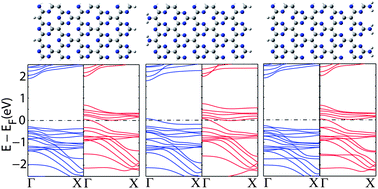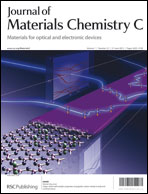Origin of the half-metallic properties of graphitic carbon nitride in bulk and confined forms†
Abstract
The electronic and magnetic properties of graphitic carbon nitride (g-C4N3) in both its bulk and confined form are investigated by using density functional theory. Our calculations show that the 2pz orbital of the carbon atoms connecting the sym-triazine structure units plays a decisive role in the half-metallic character of these materials. In the bulk two-dimensional (2D) case, the 2pz orbital of the connecting carbon atom couples weakly with the frontier molecular orbitals of the sym-triazine ring due to symmetry mismatch and a large energy separation. As a consequence a narrow energy band is formed near the Fermi level. This spin splits in virtue of the Stoner criterion and thereby gives rise to spin polarization in the (1 × 1) primitive cell. Such a magnetic state is not destroyed by a (2 × 2) reconstruction, which further enhances the half-metallic character of the 2D g-C4N3 sheet. When the dimension is reduced, size and edge effects become dominant. Both zigzag and armchair one-dimensional g-C4N3


 Please wait while we load your content...
Please wait while we load your content...